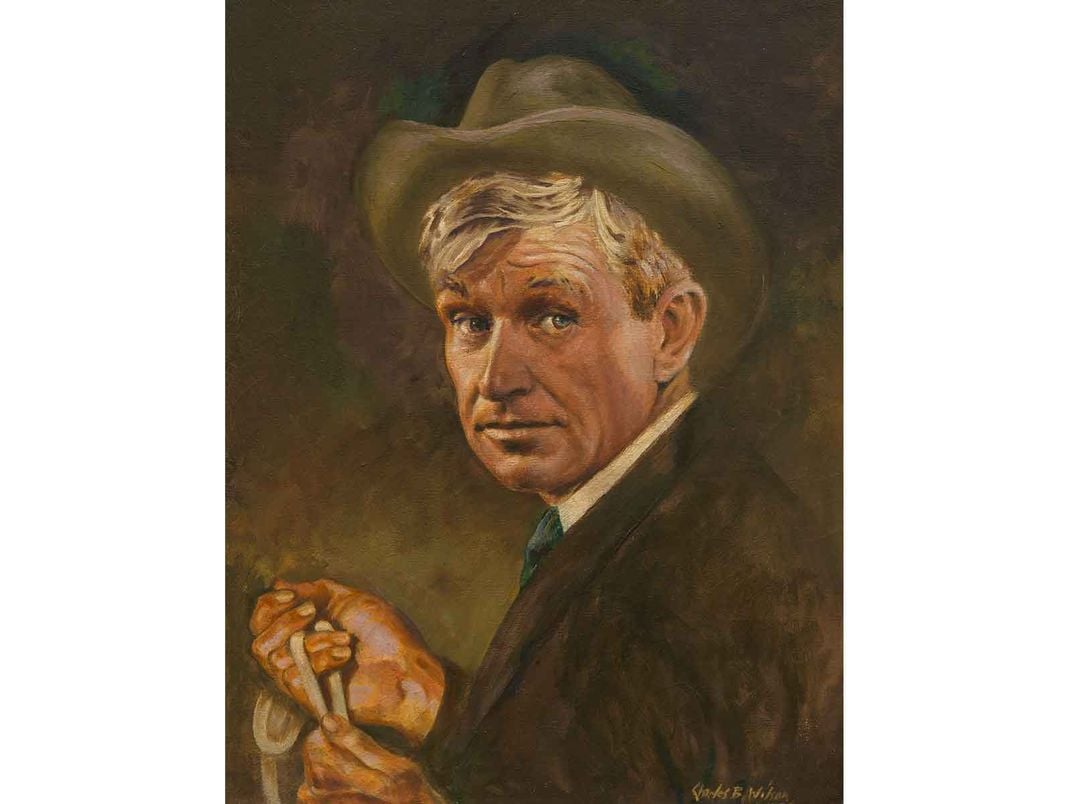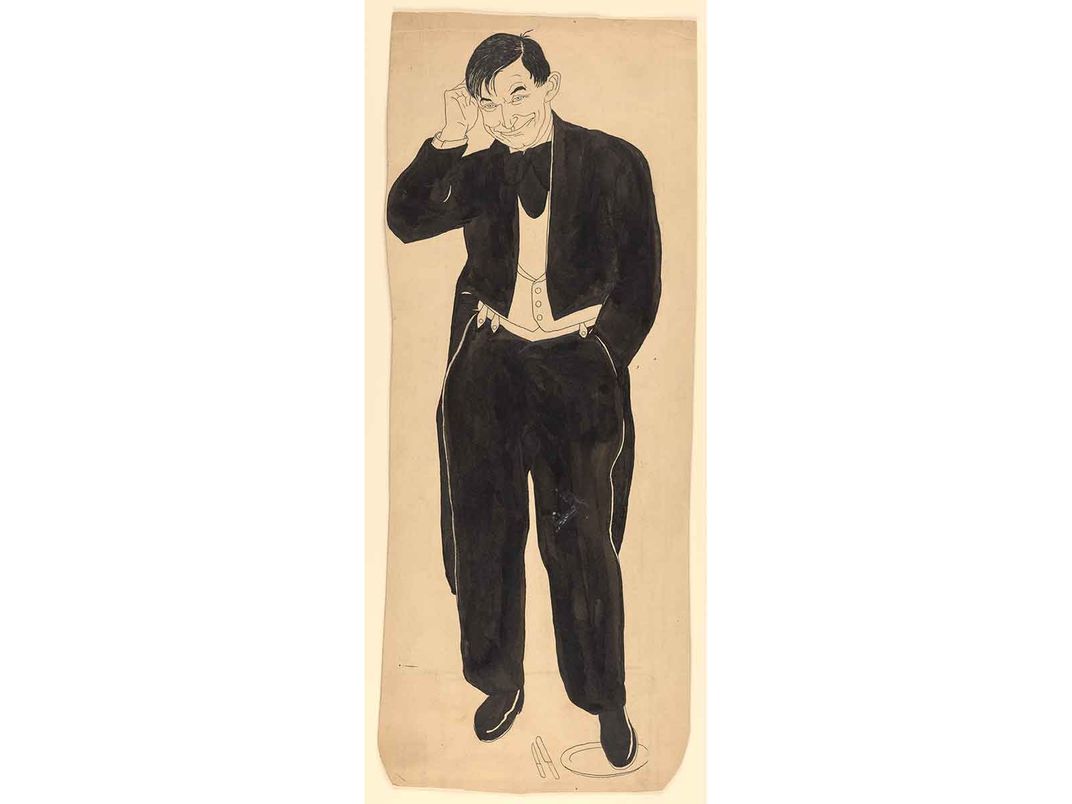Will Rogers Was One of a Kind
The popular raconteur touched Americans with his humor, newspaper columns, movie star power, philanthropy and as political agitator
:focal(700x167:701x168)/https://tf-cmsv2-smithsonianmag-media.s3.amazonaws.com/filer/c6/e0/c6e0af56-e7bb-4431-a5f6-a81a8d846c8d/untitled-1.jpg)
Between 1915 and 1935, Cowboy Philosopher Will Rogers, who brightened the dark days of the Great Depression with words of compassion and common sense, became a Broadway star, a top male movie box office star, the highest paid movie star, the most popular radio star, the most frequently requested public speaker and the most widely read daily newspaper columnist in the United States.
In today’s segmented media world with countless options available in print, through broadcasts, or on the internet, many Americans choose what they like and become deaf to performers or speakers who do not fall within their narrow range of interest. It’s CNN or Fox News, Stephen Colbert or Sean Hannity, Oprah Winfrey or Meghan McCain. No one person can claim the kind of broad audience that Rogers enjoyed.
“Will came as close to being a national spokesman during the latter part of his career as any one writer has ever become,” wrote historian Ivie E. Cadenhead Jr. His newspaper column alone reached 40 million people in a nation with a population of 123 million, roughly one-third of whom were children. His column appeared in the New York Times and 550 other newspapers, and he wrote more than 3,600 columns.
Satirist and scholar H.L. Mencken called him “the most dangerous man alive” because of his expansive influence on the American population. Author Damon Runyon described him as “America’s most complete human document.” Theologian Reinhold Niebuhr praised Rogers’s search for more truth “that more pretentious teachers leave untouched.”
Before the closing of the Smithsonian museums for the COVID-19 crisis, Rogers was to have been the focus of a now-postponed exhibition “One Life: Will Rogers” at the Smithsonian’s National Portrait Gallery. The museum’s podcast series, Portraits, devotes “Will Rogers: Removing the Sting” both to the planned exhibition and to his life. This month the Smithsonian Associates live streams an appreciation of the popular raconteur with host Daniel Shashower and actor Scott Sedar, who performs some of Roger’s monologues.
Listen to "Will Rogers: Removing the Sting"
with Smithsonian historian Jim Barber
Rogers is well-remembered for his clever observations on American society. He loved baseball and hated prohibition. He embraced the downtrodden, while castigating the powerful. Although he developed personal friendships with several presidents of the United States, happenings at both the White House and the U.S. Capitol provided fodder for many of his jokes.
Part Cherokee, Rogers was born in 1879 on his father’s sprawling 60,000-acre ranch, in the Cherokee nation in Oklahoma. After the Curtis and Dawes Acts required re-allotments of Native American lands, the family ranch dwindled to 140 acres in the late 1890s in what was known as the Indian Territory before Oklahoma became a state. Rogers became a naturalized U.S. citizen after the 1898 Curtis Act disbanded tribal governments. Both of his parents had Cherokee blood, and though his successful father fervently wanted him to be well-educated, Rogers did not like school.
As a teenager, he left home, becoming a cowboy in Argentina and performing in Texas Jack’s Wild West Circus, which was touring South Africa. Showing off the roping skills he had learned from a freed slave, he developed an on-stage persona as the Cherokee Kid.
He was “so good to the point where he could use three ropes and he could lasso a horse and a rider with three ropes,” says historian and curator Jim Barber at the National Portrait Gallery. Rogers was a cowboy, Barber adds, but unlike other popular western stars of that era, he never carried a gun. Furthermore, Rogers was different from most boys. “He had wanderlust from an early age,” Barber says. That eagerness led him to explore continents rather than complete his education.
When he ended his first foreign adventures, Rogers toured the United States’ vaudeville circuit. He first received widespread national attention after quick thinking enabled him to rope a loose steer at Madison Square Garden. Over the years, his wife Betty suggested that he talk to the audience, and he began to realize that the crowds responded well when he spoke between roping stunts and explained why a particular attempt was unsuccessful. “If he missed a trick, he had a joke that he would use,” Barber says. Soon, Rogers saw an opportunity to share his observations on current affairs. He got a job with the Ziegfeld Follies in 1915 on Broadway. He worked there for ten years, becoming the undisputed star of the show. One of the highlights of the “One Life” exhibition is a photograph of Rogers lassoing a pyramid of Ziegfeld girls.

Beginning in 1918, Rogers appeared in more than 70 films. Most were silent, but he starred in 11 “talkies.” He worked alongside actors like Mickey Rooney and with legendary directors such as John Ford and Hal Roach. He began radio performances in 1922, and in the 1930s, he launched a weekly series sponsored by Gulf Oil. His pay for the first seven weeks was $50,000, and he donated half of that to the Red Cross. As his earnings rose, he became well-known for his philanthropy. In 1931, when drought-weary farmers in England, Arkansas, went to the Red Cross and learned that the agency had run out of relief applications, they staged a food riot to draw attention to hunger in the United States. Rogers jumped on their bandwagon and performed 50 fundraising shows in Arkansas, Texas and Oklahoma.
With rising fame, his political candor and influence grew. He became a “shrewd political commentator” in the guise of “the cowboy philosopher with a big smile who could lasso anything and make anybody laugh,” says the museum’s director Kim Sajet in the Portraits podcast. Despite some very specific positions on national issues, he never seemed to alienate large portions of the public. President Dwight D. Eisenhower explained this later, saying “his favorite tool was the witty barb—but though sharp, to puncture pomposity, it was never poisoned to leave a lasting wound.” However, at least once, Rogers did offend listeners. In a January 1934 broadcast, he used the N-word four times, drawing the ire of the NAACP and African American newspapers.
In his columns, Rogers encouraged Americans to prepare to defend their nation, but he was an isolationist who opposed U.S. involvement in the affairs of other nations. In early 1935, he showed his political clout when he spurred many of the 40,000 telegrams that flooded into Congress, leading to the 1935 rejection of plans for the United States to become a member of the World Court.
With a countrified accent, Rogers attempted to link arms with ordinary Americans, always reminding them of his Native American ancestry. “My ancestors didn’t come over on the Mayflower, but they met the boat,” he said. In reality, he grew up in an affluent family, and his success made him even richer. At the peak of his career, he bought 359 acres of land in Santa Monica that became home to a 31-room house, guest quarters, a polo field, a golf course, stables, horse-racing facilities and a roping arena.

Surrendering to his wanderlust again, Rogers set off on a round-the-world tour in August 1935. He “could not sit still,” according to Barber. Traveling with one of the world’s most celebrated pilots, Wiley Post, in a two-seater plane, he began his tour in Alaska. One day, Post got lost and landed on an Alaskan lagoon to get directions from people in the area. Then, the plane lifted off, quickly lost power, and slammed into the water, killing both men instantly.
“There is a curious parallel between Will Rogers and Abraham Lincoln,” said Carl Sandburg following the crash. “They were each figures whom we could call beloved with ease and without embarrassment.” Robert Sherwood, another Lincoln scholar, wrote that “the impact upon the people of America at the death of Will Rogers was similar to that produced by the death of Lincoln.” More than 50,000 people sweltered for hours waiting for an opportunity to walk past his flag-draped casket in a Los Angeles cemetery. Movie theaters nationwide darkened their screens for two minutes at the time the funeral was set to begin.
After his death, Americans from coast to coast sent in coins to support a Will Rogers memorial. In response, the Oklahoma legislature approved $200,000 for the project. Congress passed a bill allocating $500,000 for a memorial, but President Franklin D. Roosevelt vetoed the appropriation because the plan was vague. Workers broke ground on a smaller ranch-like memorial in April 1938, and it opened later that year with FDR making a tribute to Rogers.
Will Rogers has never slipped from American popular memory. The Story of Will Rogers, a biographical film starring Will Rogers Jr. and Jane Wyman, appeared in 1952. Almost 40 years later, The Will Rogers Follies, a Broadway musical with Keith Carradine playing Rogers, debuted in 1991 and won the Tony Award for Best Musical. The show focused on Rogers’s years with the Ziegfeld Follies—just one stop in the life of a man who was constantly on the move and could honestly say, “I never met a man I didn’t like.”
/https://tf-cmsv2-smithsonianmag-media.s3.amazonaws.com/accounts/headshot/Alice_George_final_web_thumbnail.png)
/https://tf-cmsv2-smithsonianmag-media.s3.amazonaws.com/accounts/headshot/Alice_George_final_web_thumbnail.png)